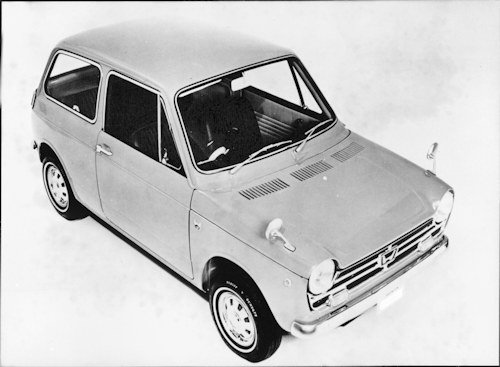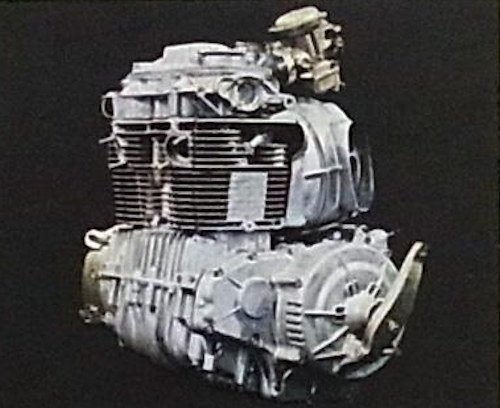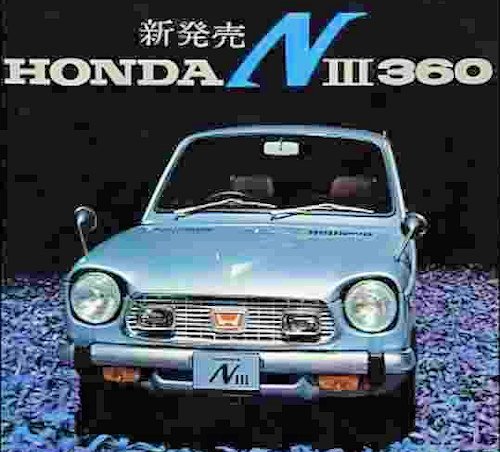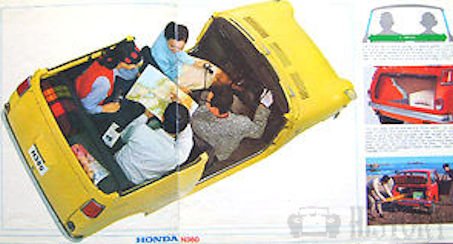Honda N360
 |
|
|
country of manufacture |
Japan |
|
Sales period |
1967 to 1971 |
|
Class |
Motor Car |
|
body type |
2-door sedan,3-door light van |
|
Drive system |
FF |
|
engine |
Air-cooled 4-stroke 2-cylinder SOHC 354cc |
|
Maximum output |
31PS/8,500rpm |
|
Maximum torque |
3.0kgf m/5,500rpm |
|
transmission |
4-speed MT /3-speed AT |
|
Wheelbase |
2,000 mm |
|
full length |
2,995mm |
|
Width |
1,295mm |
|
Height |
1,345mm-1,340mm |
|
vehicle weight |
475-520kg |
|
Production volume |
Over 650,000 |
The N360 was built from 1966 to 1971 of the car manufacturer Honda.
History
The front-wheel drive two-door sedan had an air cooled two-cylinder engine with 354 cc and 20 kW. Also, as the TN360 (type code TN360 and the product code 512) was derived as a van, which was sold with 22 kW but only in the home market Japan.
The LN360M was a "luxury model" with more accessories. Radio (MW / LW) with five channel station buttons installed in the middle of the dashboard and the telescopic antenna in the left B-pillar. Driver and passenger comfort seats folding as reclining seats and better padded interior trim. Backing (inside vertical and horizontal) for the rear side windows (sliding windows). Mud flaps on the rear wheels. A special M emblem was ever on the lower part of the two-piece tailgate and on the two front fenders. The extra charge was 40,000 yen and so you had a price advantage 15,170 yen. Around 1970, the Honda Z (type code Z360 and product code 605) and 1971 Honda Life emerged from the N360. From Life there was next to the 2- and 4-door also a van (Stepvan) and a pick-up.
It adopted a front-wheel drive (FF) system to secure a spacious cabin space, and was equipped with a high-output engine that was outstanding for a mini passenger car in 1967. It sparked the "horsepower competition" in the kei car industry at the time. The combination of high performance and low price made it the best-selling model at the time. His nickname was N-Koro , and he was also called Enusan.
Announced at the 13th Tokyo Motor Show in 1966. Sales started in March 1967. Prior to that, the company had manufactured and sold the S series of sports cars and commercial vehicles, but the number of units was limited, and this model was the company's first full-scale mass-produced passenger car. According to one theory, the "N" in the car's name is an abbreviation for "Norimono," and it is said that President Soichiro Honda named the car with the aim of popularizing it as a form of minimum transportation.
There was only one grade when it was first released, and the price was set at 313,000 yen at Saitama Factory Sayama Factory (now Saitama Factory Sayama Completed Vehicle Factory) and 315,000 yen at Tokyo and Kanagawa stores, which was set by other companies in the same class at 350,000 yen. With its high performance and low price, it became popular with the general public and became a hit. In June of the same year, a light van type "LN360" was added as a sister car.

Competitors were surprised by the high power of the "N360" and responded by raising the power of the 2-stroke engine, and for several years until just before the oil crisis, the mini-vehicle industry boasted horsepower in the catalogue output. entered the competition. Despite being a 360cc light car, it reached 36-40ps, which is equivalent to 100ps per litre of engine displacement. However, when it comes to 40ps class sports models, due to the characteristics of ultra-high rotation type, torque in the normal range is poor and there is a bad effect that reveals lack of practicality.
- PERFORMANCE: Honda N360
- max power (DIN): 31 hp at 8,500 rpm
- max torque (DIN): 22 1b ft, 3 kg m at 5,500 rpm
- max engine rpm: 8,500
- specific power: 87.6 hp/l
- Engine capacity: 21.60 cu in, 354 cu cm
- Fuel consumption: 57 m/imp gal, 47.5 m/US gal, 5 X 100 km
- Max speed:71.5 mph, 115 km/h
- power-weight ratio: 35.3 lb/hp, 16 kg/hp
- acceleration: standing 1/4 mile 22 sec
In April 1968, the "N360 AT" equipped with Honda's first automatic transmission was also released. This product was developed in-house and was called " Hondamatic." Unlike the semi-automatic "Hondamatic" with the star range that was later installed in the Civic, etc., this "Hondamatic" was a full-fledged 3-speed fully automatic, and the select lever was installed on the handlebar column. It was a 7-position type of "PRND-3-2-1" (each position of 3, 2, 1 is fixed to each gear). The maximum speed reaches 110km/h, which is almost comparable to a 4-speed MT car. In July 1968, the "N360 sunroof" with a canvas top was added. In September 1968, the T, TS, TM, and TG grades, which were equipped with twin carburettors and generated 36ps/9,000rpm, were added (T stands for Twin). Maximum speed 120km/h.
- PERFORMANCE: Twin carburettor
- max power (SAE) 36 hp at 9,000 rpm
- max torque (SAE) 23 1b ft, 3.2 kg m at 7,000 rpm
- max engine rpm 9,000
- specific power 101.7 hp/l
- power-weight ratio 30.6 lb/hp,13.9 kg/hp
- acceleration standing 1/4 mile 21 sec
Honda had already exported the "S series" overseas, but when the "N360" was developed, the "N400”, which expanded the displacement to 400cc based on this, was equipped with a 600cc engine and a maximum speed of 130km/ H "N600" was manufactured and exported to the United States and Europe. In Europe, due to the selection of manufacturers due to intensifying competition and the shift to higher-end production models, the number of inexpensive small-displacement minicars, which is the smallest class, has gradually decreased. Because it is an output vehicle, it has achieved a certain level of sales performance, receiving support from users who have restrictions on income and license system, mainly among young people.

In January 1970, it evolved into the "N III" due to another model change. In this model change, the name was officially changed to "N III 360", and the exterior was also greatly improved. The characteristic 4-speed MT has been changed from a dog mission to a general full sync type. In addition, "N III 360 Town" was added in September of the same year, with a high-speed, high-output engine that was a symbol. Town's engine, which emphasizes low-speed performance, is tuned to 27ps/7,000rpm (torque remains unchanged).
The "N360" has sold 250,000 units in less than two years since its release, and the total production volume has reached 650,000 units.
After 1969, influenced by the "defective car problem" that had become a social problem in the United States led by Ralph Nader, a movement to condemn defective cars occurred in Japan as well. One of the groups that showed this kind of movement was the Japan Automobile User Union, which pointed out that the best-selling car of the time, the N360, had serious defects in terms of steering stability. There were also accidents where factors other than defects could be seen, such as cases where the tires were shaved). In response, the Ministry of Transport reiterated the claim that "according to the materials submitted by Honda Motor Co., Ltd., there seems to be no defects." As a result of this, the image of the N360, declined, and in 1971, the successor model "Life" was released. finished. In addition, production plans for the 1300 passenger car announced in April 1969 were also affected, and the car was launched two months later than originally planned.
The company sought new developments in the mini passenger car industry with the N-series derivative " Z " and the remodelled " Life ", but it was not enough to regain what it had lost with the "N360." In 1974, the company temporarily withdrew from the mini-vehicle market, leaving only commercial vehicles. Yoshio Nakamura, who was involved in the development of the "N360," did not deny that the "N360" had "instability due to yaw characteristics and roll characteristics. It achieved a certain level of commercial success, and contributed significantly to the expansion of Honda's business performance through derivative developments such as the specialty car "Z" that shared the drivetrain and the light truck " TN360 ". After that, Honda suppressed the eccentric aspect represented by high-performance air-cooled engines, and after the N360 successor model "Life" in 1971 and the compact passenger car " Civic " released in 1972, the engines of mass-market four-wheeled vehicles were the so-called " Under the mellow route, it was decided to switch to a water-cooling system and move to a more universal design.
Interior and exterior
The 2-door, 2-box shape was designed to increase the cabin space by arranging small-diameter tires at the four corners. It had an extremely spacious cabin for a mini passenger car of the time, and its design concept and drive system were strongly influenced by the British -made Mini, which was marketed in 1959. It also has a trunk lid in common with the mini, but this model adopts a trunk through structure that omits the rear bulkhead and tray.
Soichiro Honda didn't like the original rear design, so he ordered the clay model, which had already been made for production, to be scraped with a planer and said, "Go with this." There is an anecdote that it happened.
The initial speedometer was a simple design reminiscent of a tester 's indicator, and the shift lever was a kind of " instrument panel shift " that protruded from the bottom of the dashboard. The steering shaft protrudes from the centre of the floor, and was designed to accommodate both left and right steering wheels.
Drivetrain
It adopted front - wheel drive with a transverse engine mounted at the front. The engine is a 4-stroke forced air- cooled inline 2-cylinder chain drive SOHC, developed based on the air-cooled parallel 2-cylinder DOHC engine installed in the Dream CB450. For this reason, the timing chain is placed in the middle of the camshaft and crankshaft, similar to a two-cylinder motorcycle, rather than at one end of the cylinder block like in a normal car engine.
This engine has a displacement of 354 cc and a maximum output of 31 PS at 8,500 rpm from an inner diameter x stroke of 62.5 x 57.8 (mm). Light cars made by other manufacturers at this time were mainly 2-stroke engines, and their maximum output was generally in the low 20PS range, so it was a remarkably high output. This is the result of applying the method of earning power by allowing high revs, which Honda Motor Co., Ltd. is good at with motorcycles. The nominal maximum speed of 115 km/h was also the highest level among mini passenger cars at the time. Due to the structure of the engine, noise and vibration are intense, but priority is given to ensuring performance and simplifying the structure, and anti-vibration and soundproofing measures are kept to a simple level.
The 4-speed manual transmission was close to the structure of a motorcycle in the initial model, and was equipped with a constant mesh dog mission that was arranged in series with the engine. The front suspension uses independent coil springs and struts, while the rear uses semi-elliptical leaf spring axle suspensions. The cabin heating uses the waste heat of the air-cooled engine, so the smell of gasoline and engine oil enters the room, which is disadvantageous in terms of temperature control, but simplicity was given priority.

Technical
-
Honda N360 Technical details and specifications (1967-1971)
ENGINE
location front
4 stroke, transverse; cylinders: 2, in line
bore and stroke: 2.46 x 2.28 in, 62.5 x 57.8 mm
engine capacity: 21.60 cu in, 354 cu cm
compressionratio: 8.6
cylinder block:light alloy
cylinder head: light alloy
crankshaft bearings: 4, on roller bearings
valves: 2 per cylinder. overhead, rockers
camshafts: 1, overhead; lubrication:
rotory pump, full flow filter
lubricating system capacity: 5.28 imp pt, 6.34 US pt,3 1
carburation: 1 Keihin variable Venturi horizontal carburettor
fuel feed: electric pump
cooling system: air-cooled.TRANSMISSION
driving wheels: front
clutch: single dry plate (diaphragm)
gearbox: mechanical, in unit with engine
gears: 4 + reverse
synchromesh gears: all
gearbox ratios: 1st 2.529, 2nd 1.565, 3rd 1, 4th 0.714, rev 2.440
(option) Hondamatic automatic gearbox, hydraulic torque convertor and 3-speed constant mesh gears
gear lever location: central
final drive: helical spur gears, in unit with engine and gearbox (option) 3.192 axleCHASSIS
type integral, front auxiliary frame
front suspension: independent, by McPherson, coil springs/telescopic damper struts, lower wishbones
rear suspension :rigid axle, semi-elliptic leafsprings, telescopic dampers.STEERING
rack-and-pinion
turns of steering wheel lock to lock: 3.10.
turning circle (between walls): 28.9 ft, 8.8 mBRAKES
drum
area rubbed by linings: front 37.67 sq in, 243 sq cm
area rubbed by linings: rear 37.67sq in, 243 sq cm
area rubbed by linings: total 75.34 sq in, 486 sq cm.ELECTRICAL EQUIPMENT
voltage: 12 V
battery: 26 Ah
generator type: dynamo, 250 W
(option) 300 W alternator
ignition distributor: HitachiDIMENSIONS AND WEIGHT
wheel base: 78.74 in, 2,000 mm
front track: 44.48in, 1,130 mm; rear track: 43.50 in, 1,105 mm
overall length: 117.91 in, 2,995 mm
overall width: 50.98 in, 1,295 mm
overall height: 52.76 in, 1,340 mm
ground clearance: 6.30 in, 160 mm
dry weight: 1,091 1b, 495 kg
distribution of weight: 67% frontaxle, 33% rear axle© Motor car History
Technical specifications comparison
Technical
N360
N400
N600
engine
2-cylinder four-stroke engine, air-cooled, OHC
2-cylinder four-stroke engine, air-cooled, OHC
2-cylinder four-stroke engine, air-cooled, OHC
capacity
354 cm 3
401 cm 3
599 cm 3
compression
8.5: 1
8.5: 1
8.5: 1
power
27 hp at 8000 min -1
29 hp at 8000 min -1
42 horsepower at 6600 min -1 (from '71 only 38 hp)
Max. torque
29.4 Nm at 5500 min -1
30.1 Nm at 5500 min -1
51 Nm at 5000 min -1
tare
520 kg / 530 kg
550 kg
550 kg / 560 kg
top speed
115 km / h / 110 km / h ( Hondamatic )
120 km / h
135 km / h / 130 km / h (Hondamatic)
Accelerator 0-100 km / h
36.5 s (41.1 s Hondamatic)
24 s
Length / width / height (mm)
2955/1295/1345
2955/1295/1325
3025/1320/1330
Turning circle (m)
10
10
10
Trunk
84
84
84
standard tires
5.20-10 2 PR, 145 SR 10
5.20-10 2 PR, 145 SR 10
5.20-10 2 PR, 145 SR 10
consumption
3.6 l / 100 km
5.6 l / 100 km
transmission
4-speed transmission / 3-speed Hondamatic
4-speed transmission
4-speed transmission / 3-speed Hondamatic
Service
-
Honda N360 Maintenance and Service Guide (1967-1971)
Fuel: 88 oct petrol
Engine oil, gearbox and final drive oil: 5.28 imp pt, 6.34 US pt
Greasing: none
Tappet clearances: inlet 0.006 in, 0.15 mm, exhaust 0.006 in, 0.15 mm
Valve timing: inlet opens 10° before tdc and closes 30° after bdc, exhaust opens 40° before bdc and closes 0° after tdc
Normal tyre pressure: front 24 psi, 1.7 atm, rear 20 psi, 1.4 atm.
Tyres: 5.20 x 10;
Fuel tank capacity: 5.7 imp gal, 6.9 US gal
Carrying capacity: 706 1b, 320 kg© Motor car History
